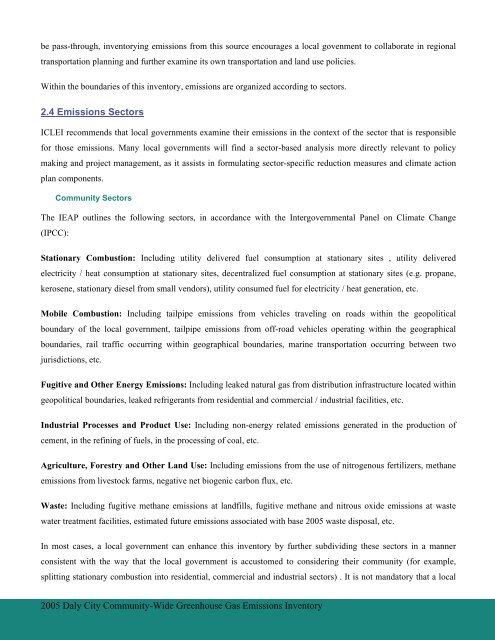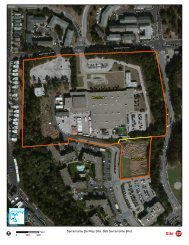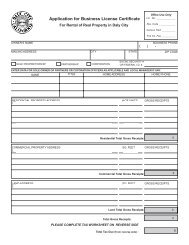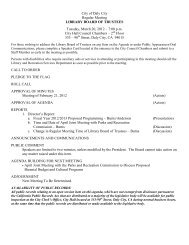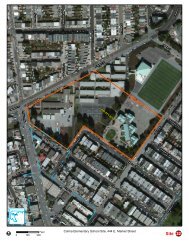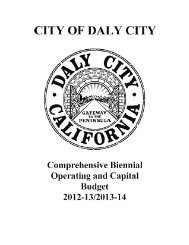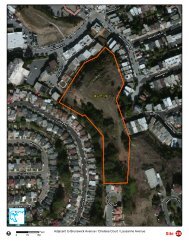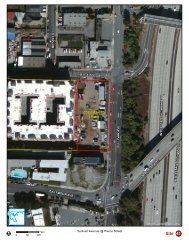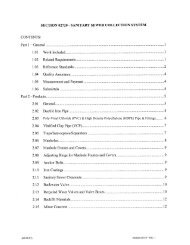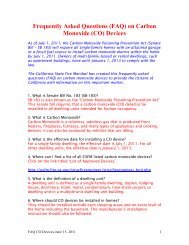Daly City's Green Vision - City of Daly City
Daly City's Green Vision - City of Daly City
Daly City's Green Vision - City of Daly City
Create successful ePaper yourself
Turn your PDF publications into a flip-book with our unique Google optimized e-Paper software.
e pass-through, inventorying emissions from this source encourages a local govenment to collaborate in regional<br />
transportation planning and further examine its own transportation and land use policies.<br />
Within the boundaries <strong>of</strong> this inventory, emissions are organized according to sectors.<br />
2.4 Emissions Sectors<br />
ICLEI recommends that local governments examine their emissions in the context <strong>of</strong> the sector that is responsible<br />
for those emissions. Many local governments will find a sector-based analysis more directly relevant to policy<br />
making and project management, as it assists in formulating sector-specific reduction measures and climate action<br />
plan components.<br />
Community Sectors<br />
The IEAP outlines the following sectors, in accordance with the Intergovernmental Panel on Climate Change<br />
(IPCC):<br />
Stationary Combustion: Including utility delivered fuel consumption at stationary sites , utility delivered<br />
electricity / heat consumption at stationary sites, decentralized fuel consumption at stationary sites (e.g. propane,<br />
kerosene, stationary diesel from small vendors), utility consumed fuel for electricity / heat generation, etc.<br />
Mobile Combustion: Including tailpipe emissions from vehicles traveling on roads within the geopolitical<br />
boundary <strong>of</strong> the local government, tailpipe emissions from <strong>of</strong>f-road vehicles operating within the geographical<br />
boundaries, rail traffic occurring within geographical boundaries, marine transportation occurring between two<br />
jurisdictions, etc.<br />
Fugitive and Other Energy Emissions: Including leaked natural gas from distribution infrastructure located within<br />
geopolitical boundaries, leaked refrigerants from residential and commercial / industrial facilities, etc.<br />
Industrial Processes and Product Use: Including non-energy related emissions generated in the production <strong>of</strong><br />
cement, in the refining <strong>of</strong> fuels, in the processing <strong>of</strong> coal, etc.<br />
Agriculture, Forestry and Other Land Use: Including emissions from the use <strong>of</strong> nitrogenous fertilizers, methane<br />
emissions from livestock farms, negative net biogenic carbon flux, etc.<br />
Waste: Including fugitive methane emissions at landfills, fugitive methane and nitrous oxide emissions at waste<br />
water treatment facilities, estimated future emissions associated with base 2005 waste disposal, etc.<br />
In most cases, a local government can enhance this inventory by further subdividing these sectors in a manner<br />
consistent with the way that the local government is accustomed to considering their community (for example,<br />
splitting stationary combustion into residential, commercial and industrial sectors) . It is not mandatory that a local<br />
2005 <strong>Daly</strong> <strong>City</strong> Community-Wide <strong>Green</strong>house Gas Emissions Inventory


